This post was originally published on this site
For many, the allure of the SUV has to do with the amount of storage that the larger vehicle bestows upon its owners. Sure, there’s the high seating arrangement and the false sense of extra safety over cars. But at the end of the day, when all the kids’ soccer gear can be stowed in the back or you can shop at the warehouse store without concern of having enough room for all the purchases, that’s really when drivers are happy they went “big.”
With the proliferation of electric SUVs on the rise, the question many have on their minds is, “will this hold as much stuff as a gas-powered SUV?” The answer is yes. Gone are the days of an EV’s battery creeping into the cargo area. It’s still an issue with hybrid and plug-in hybrids, but for pure electric vehicles, owners will have all the room they expect from an SUV.
If you’re curious just how much cargo space you’ll actually have from the electric vehicles currently on the road when the second row is folded down, we’ve compiled a list from the most room to the least, including the cargo space of the front trunk (or “frunk”). Now you can quietly buy all the things at Costco
COST,
you want.
1. 2022 Tesla Model X
The falcon-wing outfitted Tesla SUV leads the cargo-space pack. With folded second-row bench seats, Tesla
TSLA,
states that the vehicle has an impressive 85.1 cubic feet of cargo space. That’s an enormous amount of room. With the second row up, that volume drops to 37.1 cubic feet of cargo space. For a bit more storage, the Model X’s frunk has 6.5 cubic feet of space.
Total cargo space: 91.6 cubic feet
Space behind the second row: 37.1 cubic feet
2. 2022 Tesla Model Y
Telsa is also taking the number two spot on this list of EV SUV cargo room. The Model Y has 72.1 cubic feet of space behind the front seats with the second row folded down. When those seats are up, the amount of space is reduced to 30.2 cubic feet. The Model Y also has a 4.1 cubic-foot frunk. Tesla lumps sales numbers of the Model Y and Model 3 together, but even with a mysterious amount of them on the road, it’s likely the number one selling EV SUV, which means a lot of people have a lot of space in their battery-powered vehicle.
Total cargo space: 76.2 cubic feet
Space behind the second row: 30.2 cubic feet
3. 2022 Ford Mustang Mach-E
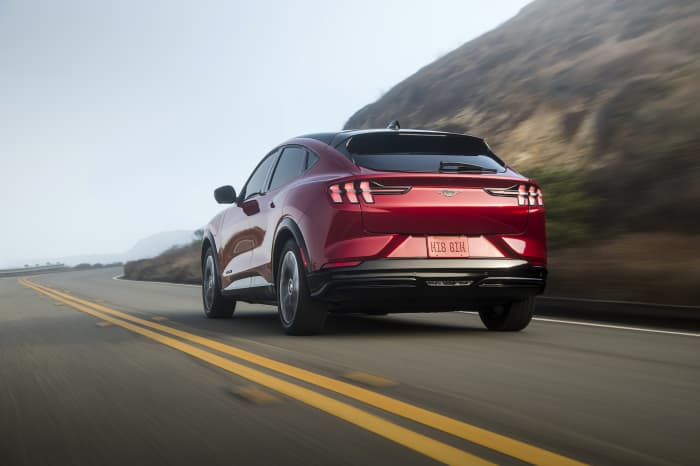
2021 Ford Mustang Mach-E
James Lipman/Ford
We can argue all day about whether the Ford
F,
Mustang Mach-E deserves the Mustang name. Mustang or not, it’s a great electric SUV with 59.7 cubic feet of total space behind the front seats, as well as a 4.8 cubic-foot frunk. With the rear seats up, interior cargo volume drops to 29.7 cubic feet. Clearly, this pony has a lot of room for your travels.
Total cargo space: 64.5 cubic feet
Space behind the second row: 29.7 cubic feet
4. 2022 Volkswagen ID.4

The VW ID.4
Volkswagen
Volkswagen’s
VWAGY,
entry into the long-range EV space begins with the ID.4 in the United States. While the ID.4 doesn’t quicken the pulse, it does deliver on the SUV promise of having enough room for the family and their gear. Behind the rear seats is 30.3 cubic feet of space. With the second row folded down, the Volkswagen has 64.2 cubic feet of space, the most interior cargo volume of all EV SUVs without a Tesla badge.
Total cargo space: 64.2 cubic feet
Space behind the second row: 30.3 cubic feet
Don’t miss: How credit cards are getting in on the electric vehicle spending trend
5. 2022 Hyundai Ioniq 5
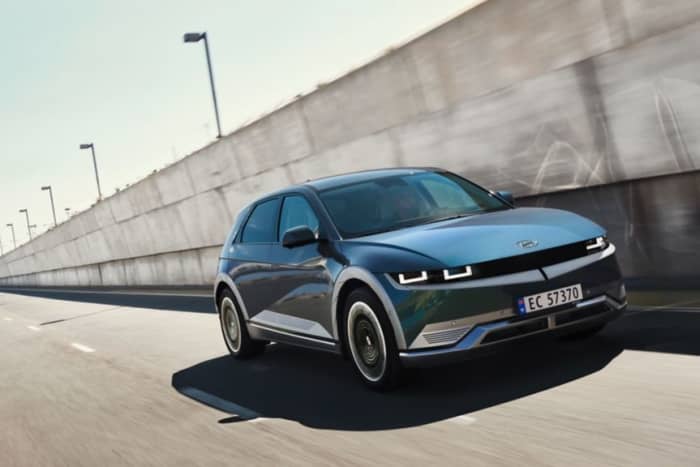
The 2022 Hyundai Ioniq 5
hyundai
Hyundai’s
HYMTF,
retro-modern hatchback-looking SUV is only barely beaten out in the cargo game by the Mach-E. The Ioniq 5 has 27.2 cubic feet of space behind the second row. With the seats down the space increases to 59.3 cubic feet. It has a small but handy 0.85 cubic-foot frunk. Those space numbers should help remind people that the Ioniq 5 is much larger than its photos let on.
Total cargo space: 60.2 cubic feet
Space behind the second row: 27.2 cubic feet
6. 2022 Chevrolet Bolt EUV
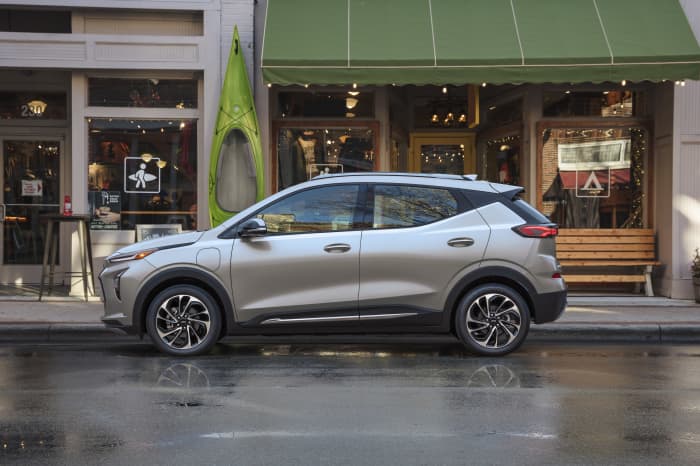
2022 Chevrolet Bolt EUV
Chevrolet
The Bolt EUV’s battery difficulties shouldn’t take away from its position as a proper small SUV with all the space that comes with that title. With the second row unfolded, the hatch area holds 16.3 cubic feet of cargo. Fold down the second row and the EUV’s cargo space jumps to 56.9 cubic feet.
Total cargo space: 56.9 cubic feet
Space behind the second row: 16.3 cubic feet
Also on MarketWatch: ‘SIM swap’ scams swiped $68 million in 2021— here’s how to protect yourself
7. 2022 Audi e-tron
Audi’s first electric luxury SUV, the e-tron has a commendable 56.4 cubic feet of cargo space with the second row folded down. Once you throw passengers in the back seat, with the seats upright the cargo space is reduced to 28.5 cubic feet.
Total cargo space: 56.4 cubic feet
Space behind the second row: 28.5 cubic feet
8. 2022 Jaguar I-Pace
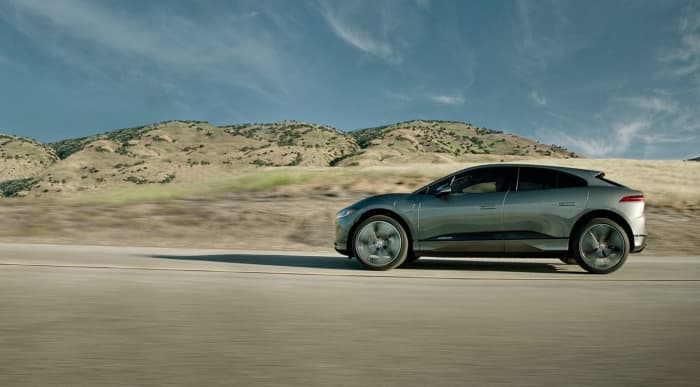
The Jaguar I-Pace
Jaguar
The Jaguar I-Pace was one of the first electric luxury SUVs to hit the market. The early-to-market vehicle has 23.3 cubic feet of cargo space behind the second row, as well as a 0.95 cubic-foot frunk. With the seats folded down, the British SUV has 54.1 cubic feet of space.
Total cargo space: 55.1 cubic feet
Space behind the second row: 23.3 cubic feet
See: This is what it would take to relieve Americans’ electric vehicle range anxiety
9. 2022 Audi e-tron Sportback
Sportiness has a price. When throwing the fastback rear end on the e-tron Sportback, the vehicle lost cargo space compared to its regular e-tron sibling. The total cargo space with the rear seats folded down is now 54.5 cubic feet. When the rear seats are ready for passengers, the trunk has 27.2 cubic feet of space available.
Total cargo space: 54.5 cubic feet
Space behind the second row: 27.2 cubic feet
10. 2022 Kia Niro EV
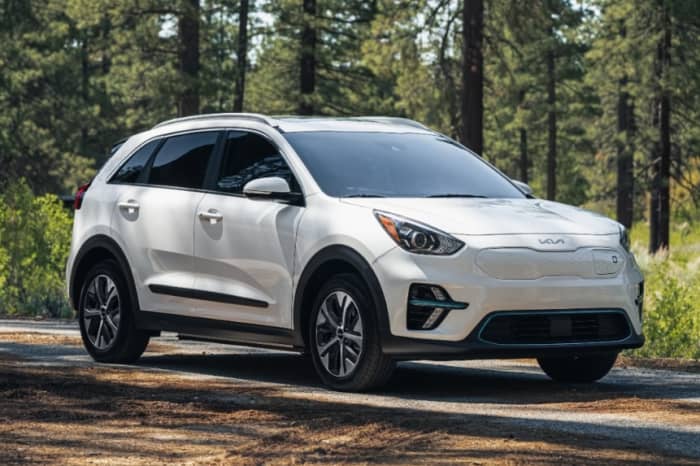
The 2022 Kia Niro
KIA
While we still miss the Kia
000270,
Soul EV, we do have the Niro EV on our shores. The Korean electric vehicle has 53 cubic feet of total space behind the front seats. With the second row unfolded, the vehicle’s trunk has 18.5 cubic feet of cargo space.
Total cargo space: 53.0 cubic feet
Space behind the second row: 18.5 cubic feet
11. 2022 Volvo XC40 Recharge
Volvo’s
VLVLY,
surprisingly quick Swedish small SUV has 16 cubic feet of space behind the second row. When you need more room, folding the rear seats down ups that number to 46.9 cubic feet. There’s also a 1.1 cubic-foot frunk.
Total cargo space: 48.0 cubic feet
Space behind the second row: 16.0 cubic feet
Read: Will Volvo come up with a self-driving car this year? Maybe.
12. 2022 Hyundai Kona Electric
The Kona Electric got an exterior upgrade recently, but its cargo space remained the same. The Kona delivers 19.2 cubic feet of cargo space behind the second row. With the rear seats folded, that number jumps up to 45.8 cubic feet, which puts it pretty far down our list of EV SUVs.
Total cargo space: 45.8 cubic feet
Space behind the second row: 19.2 cubic feet
13. 2022 Volvo C40 Recharge
What looks like a fastback version of the XC40, the C40 Recharge suffers the same storage fate as the Audi e-tron Sportback. The small Swedish SUV has 14.6 cubic feet of cargo space in the hatch. When the rear seats are folded, that number increases to 42.6 cubic feet.
Total cargo space: 42.6 cubic feet
Space behind the second row: 14.6 cubic feet
Also see: How to use telematics to monitor your teen’s driving
14. 2022 Mazda MX-30
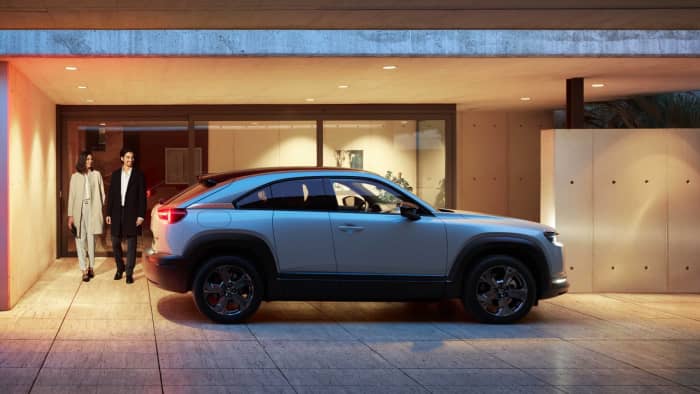
The 2022 Mazda MX30 electric
Mazda
The Mazda MX-30 has the distinction of having the least range of all the vehicles in the lineup and potentially the least amount of cargo space. Unfortunately, Mazda
MZDAY,
only shares the amount of cargo space behind the second row, which is 21 cubic feet. Hopefully, we’ll get some solid cargo space numbers in the future so we can properly place it on our list.
Total cargo space: N/A
Space behind the second row: 21.0 cubic feet
This story originally ran on KBB.com.


